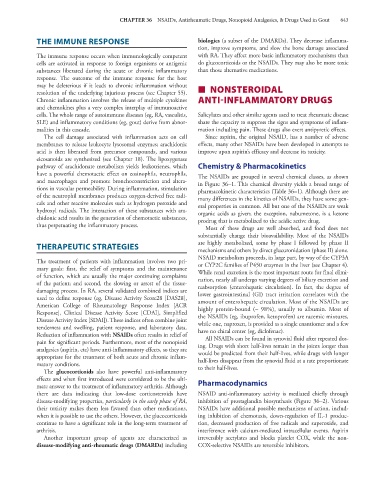Page 657 - Basic _ Clinical Pharmacology ( PDFDrive )
P. 657
CHAPTER 36 NSAIDs, Antirheumatic Drugs, Nonopioid Analgesics, & Drugs Used in Gout 643
THE IMMUNE RESPONSE biologics (a subset of the DMARDs). They decrease inflamma-
tion, improve symptoms, and slow the bone damage associated
The immune response occurs when immunologically competent with RA. They affect more basic inflammatory mechanisms than
cells are activated in response to foreign organisms or antigenic do glucocorticoids or the NSAIDs. They may also be more toxic
substances liberated during the acute or chronic inflammatory than those alternative medications.
response. The outcome of the immune response for the host
may be deleterious if it leads to chronic inflammation without
resolution of the underlying injurious process (see Chapter 55). ■ NONSTEROIDAL
Chronic inflammation involves the release of multiple cytokines ANTI-INFLAMMATORY DRUGS
and chemokines plus a very complex interplay of immunoactive
cells. The whole range of autoimmune diseases (eg, RA, vasculitis, Salicylates and other similar agents used to treat rheumatic disease
SLE) and inflammatory conditions (eg, gout) derive from abnor- share the capacity to suppress the signs and symptoms of inflam-
malities in this cascade. mation including pain. These drugs also exert antipyretic effects.
The cell damage associated with inflammation acts on cell Since aspirin, the original NSAID, has a number of adverse
membranes to release leukocyte lysosomal enzymes; arachidonic effects, many other NSAIDs have been developed in attempts to
acid is then liberated from precursor compounds, and various improve upon aspirin’s efficacy and decrease its toxicity.
eicosanoids are synthesized (see Chapter 18). The lipoxygenase
pathway of arachidonate metabolism yields leukotrienes, which Chemistry & Pharmacokinetics
have a powerful chemotactic effect on eosinophils, neutrophils, The NSAIDs are grouped in several chemical classes, as shown
and macrophages and promote bronchoconstriction and altera- in Figure 36–1. This chemical diversity yields a broad range of
tions in vascular permeability. During inflammation, stimulation pharmacokinetic characteristics (Table 36–1). Although there are
of the neutrophil membranes produces oxygen-derived free radi- many differences in the kinetics of NSAIDs, they have some gen-
cals and other reactive molecules such as hydrogen peroxide and eral properties in common. All but one of the NSAIDs are weak
hydroxyl radicals. The interaction of these substances with ara- organic acids as given; the exception, nabumetone, is a ketone
chidonic acid results in the generation of chemotactic substances, prodrug that is metabolized to the acidic active drug.
thus perpetuating the inflammatory process.
Most of these drugs are well absorbed, and food does not
substantially change their bioavailability. Most of the NSAIDs
THERAPEUTIC STRATEGIES are highly metabolized, some by phase I followed by phase II
mechanisms and others by direct glucuronidation (phase II) alone.
NSAID metabolism proceeds, in large part, by way of the CYP3A
The treatment of patients with inflammation involves two pri- or CYP2C families of P450 enzymes in the liver (see Chapter 4).
mary goals: first, the relief of symptoms and the maintenance While renal excretion is the most important route for final elimi-
of function, which are usually the major continuing complaints nation, nearly all undergo varying degrees of biliary excretion and
of the patient; and second, the slowing or arrest of the tissue- reabsorption (enterohepatic circulation). In fact, the degree of
damaging process. In RA, several validated combined indices are lower gastrointestinal (GI) tract irritation correlates with the
used to define response (eg, Disease Activity Score28 [DAS28], amount of enterohepatic circulation. Most of the NSAIDs are
American College of Rheumatology Response Index [ACR highly protein-bound (~ 98%), usually to albumin. Most of
Response], Clinical Disease Activity Score [CDAI], Simplified the NSAIDs (eg, ibuprofen, ketoprofen) are racemic mixtures,
Disease Activity Index [SDAI]). These indices often combine joint while one, naproxen, is provided as a single enantiomer and a few
tenderness and swelling, patient response, and laboratory data. have no chiral center (eg, diclofenac).
Reduction of inflammation with NSAIDs often results in relief of All NSAIDs can be found in synovial fluid after repeated dos-
pain for significant periods. Furthermore, most of the nonopioid ing. Drugs with short half-lives remain in the joints longer than
analgesics (aspirin, etc) have anti-inflammatory effects, so they are would be predicted from their half-lives, while drugs with longer
appropriate for the treatment of both acute and chronic inflam- half-lives disappear from the synovial fluid at a rate proportionate
matory conditions. to their half-lives.
The glucocorticoids also have powerful anti-inflammatory
effects and when first introduced were considered to be the ulti- Pharmacodynamics
mate answer to the treatment of inflammatory arthritis. Although
there are data indicating that low-dose corticosteroids have NSAID anti-inflammatory activity is mediated chiefly through
disease-modifying properties, particularly in the early phase of RA, inhibition of prostaglandin biosynthesis (Figure 36–2). Various
their toxicity makes them less favored than other medications, NSAIDs have additional possible mechanisms of action, includ-
when it is possible to use the others. However, the glucocorticoids ing inhibition of chemotaxis, down-regulation of IL-1 produc-
continue to have a significant role in the long-term treatment of tion, decreased production of free radicals and superoxide, and
arthritis. interference with calcium-mediated intracellular events. Aspirin
Another important group of agents are characterized as irreversibly acetylates and blocks platelet COX, while the non-
disease-modifying anti-rheumatic drugs (DMARDs) including COX-selective NSAIDs are reversible inhibitors.

